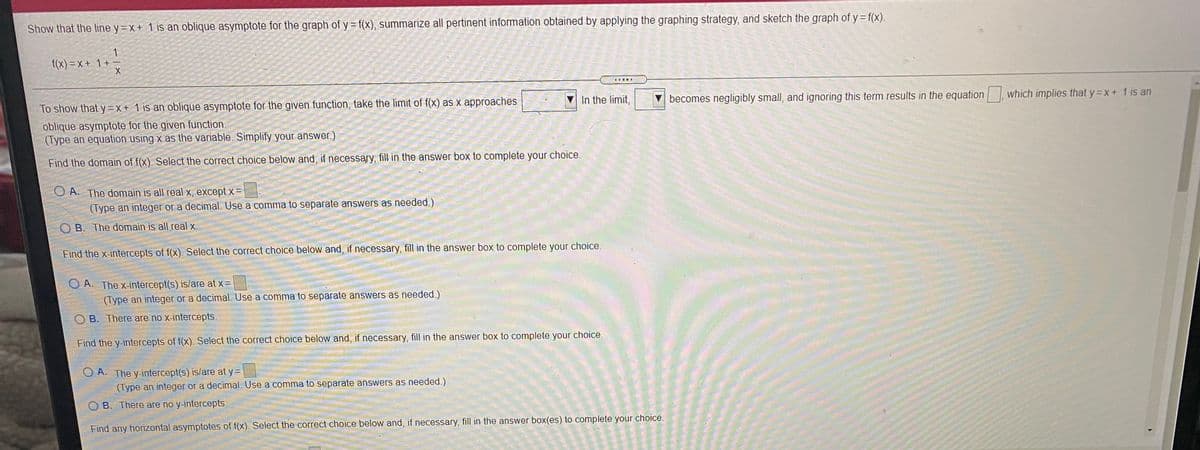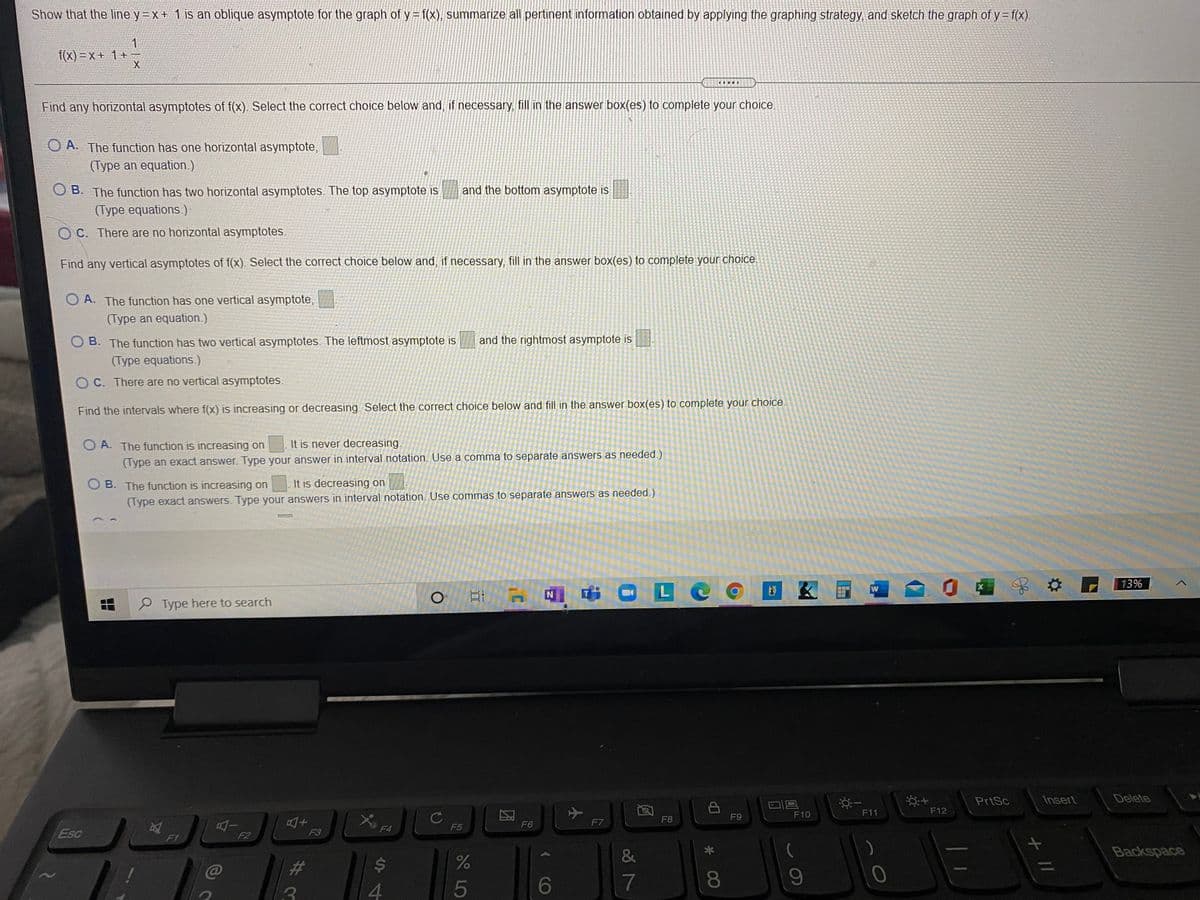Show that the line y=x+ 1 is an oblique asymptote for the graph of y = f(x), summarize all pertinent information obtained by applying the graphing strategy, and sketch the graph of y = f(x) 1. ((x)=x+ 1+ V In the limit, V becomes negligibly small, and ignoring this term results in the equation which implies that y =x+ 1 is an To show that y =x+ 1 is an oblique asymplote for the given function, take the limit of f(x) as x approaches oblique asymptote for the given function. (Type an equation using x as the variable Simplify your answer.) Find the domain of ((x) Select the correct choice below and, if necessary, fill in the answer box to complete your choice O A. The domain is all real x, except x= (Type an integer or a decimal. Use a comma to separate answers as needed.) O B. The domain is all real x Find the x-intercepts of f(x) Select the correct choice below and, if necessary, fill in the answer box to complete your choice. O A. The x-intercept(s) islare at x= (Type an integer or a decimal. Use a comma to separate answers as needed.) O B. There are no x-intercepts Find the y-intercepts of 1(x). Select the correct choice below and, if necessary, fill in the answer box to complete your choice O A. The y-intercept(s) is/are at y= (Type an integer or a decimal. Use a comma to separate answers needed.) OB. There are no y-intercepts Find any horizontal asymptotes of f(x) Select the correct choice below and, if necessary, fill in the answer box(es) to complete your choice.
Show that the line y=x+ 1 is an oblique asymptote for the graph of y = f(x), summarize all pertinent information obtained by applying the graphing strategy, and sketch the graph of y = f(x) 1. ((x)=x+ 1+ V In the limit, V becomes negligibly small, and ignoring this term results in the equation which implies that y =x+ 1 is an To show that y =x+ 1 is an oblique asymplote for the given function, take the limit of f(x) as x approaches oblique asymptote for the given function. (Type an equation using x as the variable Simplify your answer.) Find the domain of ((x) Select the correct choice below and, if necessary, fill in the answer box to complete your choice O A. The domain is all real x, except x= (Type an integer or a decimal. Use a comma to separate answers as needed.) O B. The domain is all real x Find the x-intercepts of f(x) Select the correct choice below and, if necessary, fill in the answer box to complete your choice. O A. The x-intercept(s) islare at x= (Type an integer or a decimal. Use a comma to separate answers as needed.) O B. There are no x-intercepts Find the y-intercepts of 1(x). Select the correct choice below and, if necessary, fill in the answer box to complete your choice O A. The y-intercept(s) is/are at y= (Type an integer or a decimal. Use a comma to separate answers needed.) OB. There are no y-intercepts Find any horizontal asymptotes of f(x) Select the correct choice below and, if necessary, fill in the answer box(es) to complete your choice.
Chapter3: Functions
Section3.3: Rates Of Change And Behavior Of Graphs
Problem 2SE: If a functionfis increasing on (a,b) and decreasing on (b,c) , then what can be said about the local...
Related questions
Question

Transcribed Image Text:Show that the line y = x + 1 is an oblique asymptote for the graph of y = f(x), summarize all pertinent information obtained by applying the graphing strategy, and sketch the graph of y = f(x).
f(x) = x+ 1+ -
重 :
which implies that y=x+ 1 is an
In the limit,
becomes negligibly small, and ignoring this term results in the equation
To show that y =x+ 1 is an oblique asymptote for the given function, take the limit of f(x) as x approaches
oblique asymptote for the given function.
(Type an equation using x as the variable. Simplify your answer.)
Find the domain of f(x). Select the correct choice below and, if necessary, fill in the answer box to complete your choice.
O A. The domain is all real x, except x =
(Type an integer or a decimal. Use a comma to separate answers as needed.)
O B. The domain is all real x.
Find the x-intercepts of f(x). Select the correct choice below and, if necessary, fill in the answer box to complete your choice.
O A. The x-intercept(s) is/are at x =
(Type an integer or a decimal. Use a comma to separate answers as needed.)
B. There are no x-intercepts.
Find the y-intercepts of f(x). Select the correct choice below and, if necessary, fill in the answer box to complete your choice.
O A. The y-intercept(s) is/are at y =
(Type an integer or a decimal. Use a comma to separate answers as needed.)
B. There are no y-intercepts.
Find any horizontal asymptotes of f(x). Select the correct choice below and, if necessary, fill in the answer box(es) to complete your choice.

Transcribed Image Text:Show that the line y=x+ 1 is an oblique asymptote for the graph of y= f(x), summarize all pertinent information obtained by applyıng the graphing strategy, and sketch the graph of y= f(x).
f(x) = x + 1 +-
Find any horizontal asymptotes of f(x). Select the correct choice below and, if necessary, fill in the answer box(es) to complete your choice.
O A. The function has one horizontal asymptote,
(Type an equation.)
and the bottom asymptote is
O B. The function has two horizontal asymptotes. The top asymptote is
(Type equations.)
O C. There are no horizontal asymptotes.
Find any vertical asymptotes of f(x). Select the correct choice below and, if necessary, fill in the answer box(es) to complete your choice.
O A. The function has one vertical asymptote,
(Type an equation.)
O B. The function has two vertical asymptotes. The leftmost asymptote is
and the rightmost asymptote is
(Type equations.)
O C. There are no vertical asymptotes.
Find the intervals where f(x) is increasing or decreasing. Select the correct choice below and fill in the answer box(es) to complete your choice.
O A. The function is increasing on
It is never decreasing.
(Type an exact answer. Type your answer in interval notation. Use a comma to separate answers as needed.)
O B. The function is increasing on
It is decreasing on
(Type exact answers. Type your answers in interval notation. Use commas to separate answers as needed.)
13%
LCO
IType here to search
PrtSc
Insert
Delete
F10
F11
F12
C
F5
F8
F9
F6
F7
F4
Esc
F2
F3
F1
&
Backspace
C@
%23
%3D
5
7
080
CO
Expert Solution
This question has been solved!
Explore an expertly crafted, step-by-step solution for a thorough understanding of key concepts.
This is a popular solution!
Trending now
This is a popular solution!
Step by step
Solved in 4 steps with 4 images

Recommended textbooks for you

